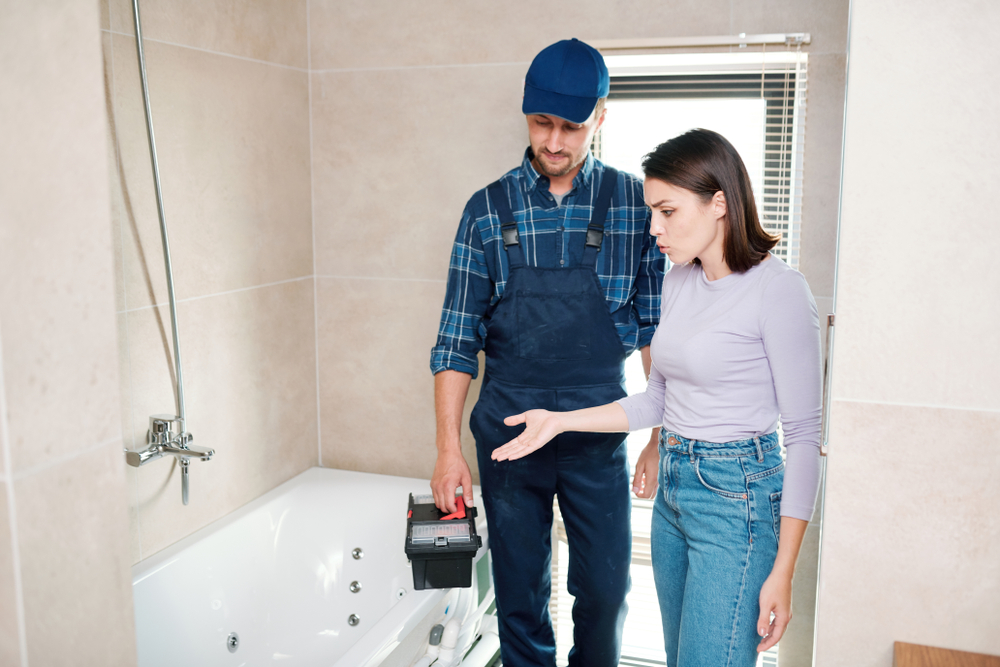You hop in the shower, glance down, and notice that little space where your tile meets the tub.
Instantly, it looks suspicious. Is it supposed to be there? Did something go wrong during installation? Or is your tub about to collapse into the basement?
Take a deep breath. That gap is actually normal.
It might not look normal, but it serves a purpose. Tubs and walls aren’t glued together like Legos. They’re two different surfaces, and both of them move – just a little bit, but enough that you need some flexibility between the two.
In this post, we’ll explain where there’s a gap between tile and tub, and how to fill it up if the gap is too wide.
Why Is There A Gap Between Tile And Tub?
It feels strange to see a crack-like space in such a “finished” spot, but that joint is intentional.
Let us explain:
First off, tubs expand and contract. Hot baths, cold water, and everyday use cause tiny shifts in the material. Same thing with the tile wall above it.
If the tiles were installed right up against the tub, the constant movement would crack the grout or even the tiles themselves.
Second, tubs (especially fiberglass and acrylic ones) can flex a little when people step in and out. That movement transfers right to the edge. Without a gap, that stress ends up breaking the tile.
Also Read: Toilet Flange Too High
So, that gap you see isn’t sloppy work. It’s actually the buffer zone!
How Wide Should The Gap Be?
There isn’t one exact measurement that fits every bathroom, but there is a general range.
A typical gap between tile and tub should run between 1/8 inch and 1/4 inch.

That’s wide enough to give the caulk room to bond and flex, but not so wide that it looks like a canyon along your tub.
Too narrow, and you won’t have enough space for the caulk to actually seal. Too wide, and the caulk may sag or pull away over time. If yours falls somewhere in that sweet spot, you’re good.
But if it’s much bigger, that could point to an installation issue or settling in the home.
What Happens If The Gap Isn’t Sealed Properly?
A visible gap might seem small, but water is sneaky.
The tiniest opening is like a welcome mat for leaks. Water that slips behind your tiles or under the tub can cause damage fast.
The wallboard behind the tile isn’t waterproof, and once it gets wet, it starts to crumble. Mold and mildew set up shop, and before you know it, you’re dealing with soft walls or loose tiles.
What’s worse is that moisture can travel down into flooring or framing.
What started as a little line between tile and tub can eventually lead to costly structural repairs!
So, while that gap is normal, leaving it unsealed is like leaving the lid off a jar of paint – it’s just asking for trouble, so we recommend you do something about it.
Also Read: Can You Use PVC Glue On CPVC?
How To Fill The Gap Between Tile And Tub
Now let’s talk about how to actually seal that gap between tile and tub.
The material of choice here is caulk, NOT grout. Grout is rigid and cracks under movement. Silicone caulk, on the other hand, stays flexible and waterproof, which is exactly what you need in a wet bathroom.
Here’s how to get it done step by step:
#1 Gather The Tools And Materials
You don’t need an entire workshop for this job. These few simple items will cover it:
- A tube of 100% silicone bathroom caulk (look for mold-resistant on the label)
- Caulking gun
- Utility knife or caulk removal tool
- Painter’s tape
- Paper towels or rags
- Rubbing alcohol or cleaner
- A cup of water and your finger (yes, really)
Having everything ready makes the job smooth from start to finish.
#2 Remove Old Caulk
If the gap already has caulk in it, you’ll want to strip it out completely.
Grab a utility knife, caulk removal tool, or even a razor scraper. Work slowly and carefully along the joint so you don’t nick the tub or chip a tile edge.
Get every bit of the old bead out, even the tiny stubborn pieces hiding in corners.

Once you’ve scraped most of it out, run a cloth over the seam to feel for any bumps you missed. If it’s rough, keep working until it’s clean and smooth.
Also Read: Heat Pump Outside Unit Not Running
#3 Clean And Dry The Surface
After removing the old bead, scrub the area with a cleaner that cuts through soap and oils.
Rubbing alcohol works great. It evaporates fast and leaves no residue.
Wipe everything down with paper towels or a rag until it’s spotless. Then let the seam dry completely. If there’s even a little moisture in the joint, the caulk won’t grab the way it should.
A quick trick: point a hair dryer at the gap for a couple of minutes.
It speeds things up and guarantees a dry surface.
#4 Apply The Painter’s Tape
Now grab the painter’s tape. Without it, it’s easy to smear caulk too high on the tile or too far across the tub. With it, you’ll get razor-sharp lines every time.
Run one strip along the edge of the tub and another parallel strip just above on the tile. Leave about an eighth of an inch gap between the two strips.
That’s your channel for the caulk.
Press the tape down firmly so no caulk sneaks underneath.
#5 Run A Smooth Caulk Bead And Tool The Joint
Load the caulking gun, snip the tip at a 45-degree angle, and puncture the inner seal on the tube. Start at one corner and pull the gun along the joint in one smooth motion.
Once the bead is down, it’s time to “tool” it.
Also Read: Toilet Flange 1/2 Above Floor
Dip your finger in water or keep a damp rag handy, then run your finger lightly along the caulk line. This pushes the caulk into the joint, smooths out the bumps, and gives it that perfect curved finish.
Keep some paper towels nearby to wipe your finger clean as you go.
If you’re not into using your finger, a plastic caulk tool works too, but honestly, most people swear by the finger method as it just feels easier to control.
#6 Let It Cure
This is the step people are most tempted to rush, but it’s the most important.
Fresh caulk looks dry in an hour, but that doesn’t mean it’s ready for water. Silicone caulk usually needs about 24 hours to fully cure. Some “fast-dry” versions claim 6 – 8 hours, but giving it a full day is the safest bet.
During curing time, avoid showers, baths, or even splashing water on the joint.
If you interrupt the cure, the bead can wrinkle, peel, or pull away.
Bottom Line
That gap between tile and tub is totally normal. It’s there to handle movement and keep your bathroom from cracking apart.
The important part is sealing it properly with silicone caulk.
A neat, flexible bead of caulk not only keeps the area looking sharp, it also blocks water from sneaking in and causing expensive damage. It’s one of those small maintenance jobs that pays off big in the long run.
So, grab a tube of caulk, take an hour this weekend, and seal it up.



